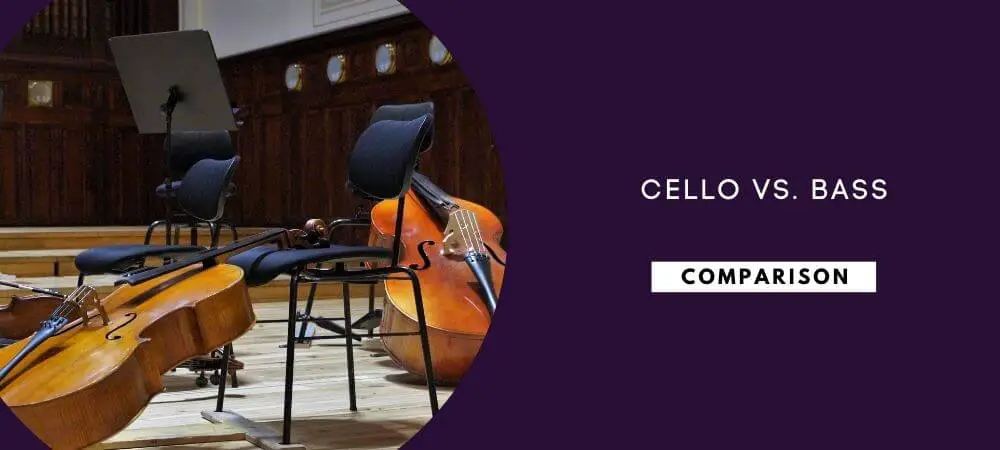The cello and bass are the two largest instruments in a string orchestra. Both instruments belong to the violin family, and they both rest on the floor while playing.
But that’s just as far as their similarities go.
Though they may appear similar, these two string instruments have distinct differences regarding how they are tuned, played, their sound, and even their roles in an orchestral setting.
Let’s take a deep dive into the cello vs bass comparison, shall we?
Table of Contents
Quick Summary
| Cello | Bass | |
| Full Size | 5’ | 6’5” |
| Tuning |
Tuned in 5ths C-G-D-A |
Tuned in 4ths E-A-D-G |
| Range | 5 Octaves | 4 Octaves |
| Sound | Tenor voice | Deep, rich tone |
| Tuning System | Tuning pegs | Tuning machines |
| Playing Position | Seated | Seated or Standing |
The Main Differences Between Cello And Bass
Size
The violin family consists of the violin, viola, cello, and upright bass. Of all these instruments, the cello and the bass are the two largest instruments in the violin family and the string orchestra.
The cello is the second largest instrument in a string orchestra. It stands at about 5ft tall and is only slightly smaller than the bass.
On the other hand, the double bass stands at about 6ft tall, and it is the largest instrument in the string family. The size of the bass makes its portability challenging, especially if you consider the full-size bass.
Strings & Tunings
Both the cello and the bass have thicker strings than violins. However, because it’s larger and taller, the bass has longer and thicker strings than the cello.
Cellos are tuned in fifths to C, G, D, and A from low to high.
The upright bass is tuned in fourths, and actually, this is the only bowed stringed instrument that you tune in fourths. A bass’s strings are tuned to E, A, D, and G from low to high.
Octaves & Notes
The double bass is tuned one whole octave lower than the cello, which means that the low E on a bass is lower than the Cello’s low C string.
While the cello has a much wider range, maxing out at about five octaves, the double bass can only handle four octaves.
Despite the difference in their ranges however, many cello and bass notes overlap.
Role In Orchestra
The string section of an orchestra is typically composed of violin, viola, cello, and double bass.
Cellos have a tenor voice that’s deeper and richer than violins and violas. Cellos have a very diverse sound, and in an orchestra, they can play melody, harmony, or support the bass line.
On the other hand, the bass has a deeper sound than the cello, and it usually plays the steady bass line behind the music.
A large symphony orchestra typically has 12 cellos and 8 double basses. When working together, these two instruments will set the rhythmic foundation for the rest of the orchestra.
Tuning System
Cellos use tuning pegs, which essentially stick out of the side of the scroll.
The double bass uses tuning machines, which typically stick out of the back of the scroll, pointing backward.
Bows
Cello bows are typically 72 to 73cm long. They are longer and skinnier than bass bows, and they also have lighter hairs than what you would find on a bass bow.
There are two main types of bass bows: the French bow and the German bow.
The French bow, also known as the Bottesini bow, resembles the cello bow, only about 10cm shorter and three times heavier than the latter. This bow is held with an overhand grip, whereby the palm faces downwards.
The German bow, also known as the Simandl or Butler bow, is held with an underhand grip, with the palm facing upwards.
Playing Position
The cello is the only instrument in the string family that must be played sitting down.
On the other hand, bass players can stand or sit on a tall stool to play their instrument.
How To Hold Cello Vs. Bass
How To Hold a Cello: Step By Step
Step 1: Sit up straight in a chair.
You can sit on the edge of the chair or against the back. All that matters is that you sit up straight, maintaining good posture. Don’t slouch.
Step 2: Hold the cello’s neck to the left side of your head.
Ideally, you want the C-string tuning peg to be approximately the same height as your ear.
Step 3: Adjust the cello’s endpin so that the instrument’s body rests against your chest.
Ensure the endpin is rooted securely onto the floor so it won’t slip while you play.
Step 4: Balance the lower half of the cello between your knees, holding the instrument steady but without gripping it between the legs.
Pro Tip: Slightly angling the cello base to the right will allow cello players to easily reach all of the strings as you bow the instrument.
How To Hold Bass: Step By Step
When playing the bass, the player can stand or use a stool. We shall explain both playing positions.
a) Standing Position
Step 1: Stand up straight, with your feet spaced shoulder-width apart.
Step 2: Adjust the endpin of the double bass such that the fingerboard’s nut is at about the same level as your eyebrows.
This is a bit contentious because some bass players recommend adjusting the nut to be as high as the top of the forehead rather than at eyebrow level.
At the same time, other players use their knuckles for reference when adjusting the height of the double bass. To do this, the bass player holds the neck of their instrument using their left hand, then drops their right hand straight down against their body.
You then adjust the endpin so that the bass’s bridge touches the fingernails or knuckles of your right hand.
Step 3: Turn the double bass slightly to the right, then angle it back slightly so that the back of the instrument rests against your left hip.
b) Seated Position
Step 1: Adjust the endpin so that the nut on the fingerboard is at the level of your eyebrows. Do this while standing.
Step 2: Sit on the front half of your tall stool.
You may either keep both feet on the floor, or you could choose to keep your right foot on the floor and the left one placed on the stool’s rung. Just select the position that’s most comfortable for you.
Step 3: Turn the double bass slightly to the right, leaning the instrument’s back against the left side of your stomach.
Cello Vs. Bass FAQs
Can A Cello Be Used As A Bass?
Yes, a cello can be used as a bass.
The best way to go about this when playing bass lines on a cello would be to play pizzicato, meaning you’re plucking the string instrument with your fingers.
Since the cello tuning has a shorter scale length, playing bass lines will require the cellist to have faster hand motions as you attempt to cover the fifths.
On the downside, the acoustic volume won’t be as loud as the double bass, so you might need to play amplified.
Similarly, you will lack that big low end because a cello is missing a whole octave, compared to the bass. So you will have a reduced low range, and the resulting bass tone won’t be as low as on double bass.
Which Is Easier To Learn: Bass Or Cello?
The cello is easier to learn than the bass but harder to master.
Like other string instruments, the initial difficulty of learning either the cello or the bass is mostly just getting accustomed to all the motions as you learn how to interact with your new instrument.
From this perspective, the cello would be easier to learn because it is a smaller, less fatiguing instrument. At the same time, you are more likely to find a cello teacher than a bass teacher, so you can start lessons sooner on the cello.
That being said, the cello has a far more extensive and demanding repertoire, and cello techniques run much deeper than that of the bass. So looking at it from this angle, the cello would be harder to learn.
Is Cello Bigger Than Bass?
No, the cello isn’t bigger than bass. The bass is bigger than the cello.
As a matter of fact, the bass is the largest string instrument in the modern symphony orchestra. A full-size bass is taller than the average person, standing at about 6’5” or 75”.
On the other hand, the largest cello is about 5’, or 60”.
Conclusion
Now that you’ve gone through the cello vs. bass comparison, you are in a better position to see that the cello isn’t merely a small double bass.
The two instruments may look similar, but the difference between both instruments are pretty distinct, and now, you know how to tell them apart.





